New York City Ballet presents its annual Fall Gala at Lincoln Center.
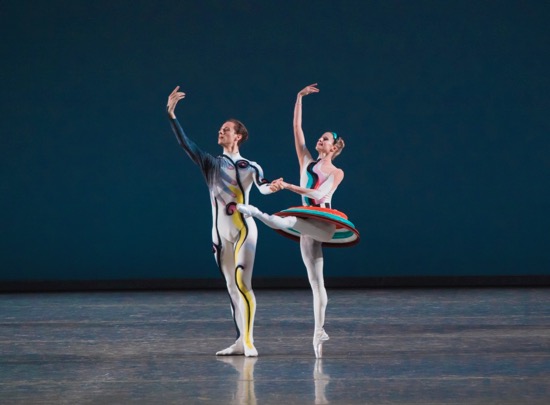
New York City Ballet’s Sterling Hyltin and Andrew Scordato in Justin Peck’s Pulcinella Variations. Photo: Paul Kolnik
“Practice makes perfect” may be a mantra for dancers and choreographers. It also describes how smoothly and fleetly the New York City Ballet’s 2017 Fall Gala—its sixth pairing choreographers with fashion designers—leapt onto and off the stage at Lincoln Center during the second week of the company’s season. Last year five choreographers participated, this year only four. Only one film of backstage scenes was shown, instead of the screen dropping down between each ballet to give us insights. No intermissions either (this effectively reduced the problem of stepping on some marvelously dressed woman’s train in the lobby).
Three of the four choreographers are currently members of NYCB: Lauren Lovette is a principal dancer, Justin Peck and Troy Schumacher are soloists. While enrolled in NYCB’s affiliated School of American Ballet, Lovette and Gianna Reisen participated in SAB’s annual Student Choreography Workshops and later in the NYCB’s affiliated Choreographic Institute; Peck and Schumacher were involved in the latter. Schumacher runs his own small company, BalletCollective. Peck, who has already choreographed 30 ballets to considerable acclaim, is NYCB’s choreographer in residence. Reisen, the only one who hasn’t presented a work in a previous Fall Gala, is currently an apprentice in Ballet Semperoper Dresden; she is 18 years old.
So the four grew up not only seeing and dancing in ballets by masters such as George Balanchine and Jerome Robbins, but being taught the ways in which movement and structure can be manipulated and matched to music. Their talent and promise were nurtured and continue to grow. As for the dancers participating in the Gala, they all seemed excited to be appearing in new choreography by their peers, and one of the pleasures for those watching was noticing terrific performers who don’t always dance in the spotlight.
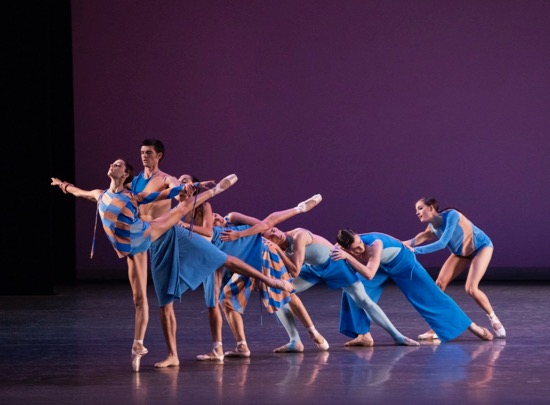
Troy Schumacher’s The Wind Still Brings. Heading the line: Eliza Blutt and Peter Walker; adding on at the the end: Mimi Staker. Photo: Paul Kolnik
All the choreographers chose music by 20th-century composers, and all collaborated with designers they admired. In some cases, however, they made 21st-century choices. Jonathan Saunders costumed the fourteen dancers—all members of the corps de ballet—in Schumacher’s The Wind Still Brings in various becoming outfits striped in royal blue, lighter blue, and mild orange; trunks, shorts, or sarongs are worn by men or women (the slim ribbons flying from them are more than a little distracting). The choreography is set to three sections of William Walton’s Piano Quartet in D minor, conducted by Andrew Lytton with Alan Moverman on the piano.
Schumacher knows well how to break unison into canon, to form expressive patterns, to drop soloists out of a group and reabsorb them. One his most potent images has to do with awakening and regeneration. It begins during Walton’s “Andante tranquillo”with a dancer falling to the floor; another kneels and bends over him/her or lies down too. Then both rise. The process gradually expands, with many dancers “helping” others in the same way. What the wind brings in, however, isn’t always clear. Sometimes the rushing dancers stop, as if that current of air had stilled. Occasionally, somewhat enigmatically the choreography hints at awkward love or jealousy: a woman presses her cheek to that of her partner, a woman backs away from the man with whom she’s been dancing; is it that his solo tells her something off-putting about him (I believe this male dancer was Devin Alberda).
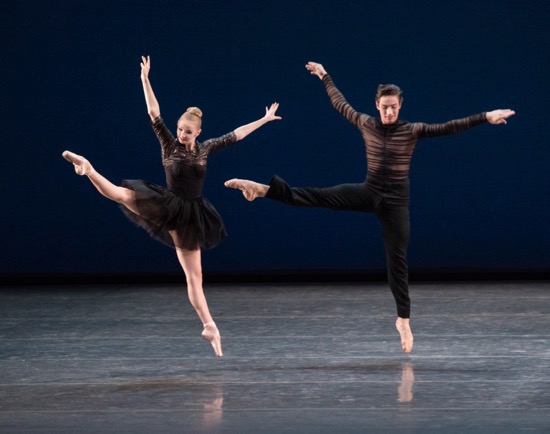
Composer’s Holiday by Gianna Reisen. NYCB dancers Emma Von Enck and Roman Mejia. Photo: Paul Kolnik
Reisen may be young, but her choreography for Composer’s Holiday is mature and quite accomplished. The opening image is both mysterious and engrossing (by that I mean that it doesn’t matter that you don’t immediately understand it). Three men are holding an inert woman high overhead, while four women seated on the floor, all raise one arm on a diagonal, as if saying “lo, there she is.” The woman is not, of course, dead, but ready to acknowledge a partner and get fast and playful. Perhaps Reisen’s choices were sparked by what she heard in Lukas Foss’s Three American Pieces for Violin and Piano (played by Arturo Delmolino and Susan Walters and led by Andrew Sill). A corps of four men and four women in various ways “support” the bright-dancing principal couples Christina Clark and Gilbert Bolden III (replacing Kennard Henson) or Emma Von Enck and Roman Mejia (both strong, self-possessed men are apprentices in the company!).
The costumes by Virgil Abloh of Off-White™ are variations on ballet tradition. The women wear sleeved semi-tutus in black, white, or pale peach; the men are clad in black tops and trousers. The stellar young cast members periodically watch one another the way they might during a class. Reisen keeps us interested throughout this promising debut. She sends the principal couples, the men lifting their partners, along a diagonal avenue of kneeling colleagues. Clustering, they support a woman, as she climbs up their backs and shoulders toward the light, then throw her into sudden darkness.
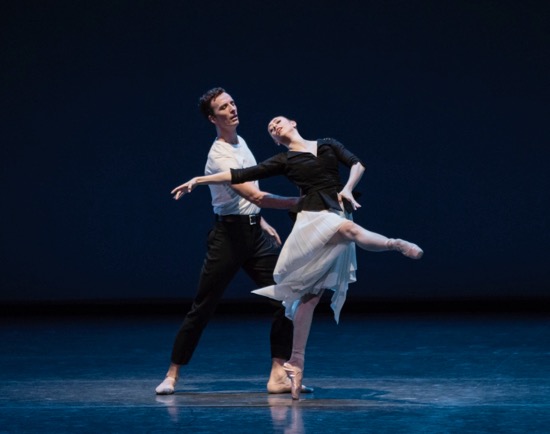
Lauren Lovette’s Not Our Fate: Ask la Cour and Meaghan Dutton-O’Hara. Photo: Paul Kolnik
Not Our Fate is Lovette’s second ballet for the company; she made her choreographic debut in last year’s Fall Gala. The music she chose this time begins with repetitive patterns that identify the composer as Michael Nyman (sections 1, 4, and 5 from his Concert Suite from Prospero’s Books). A poem by Mary Elizabeth Sell (who also dances in the piece) appears in the program, indicating Lovette’s themes: connections made and sundered, the rush toward what is desired and away from what is feared, choice rather than fate as a guiding principle. Fernando Garcia and Laura Kim of MONSE and Oscar de la Renta have given Lovette’s dancers the most elegant costumes of the evening and, on a certain level, the simplest. The five men wear high-grade white t-shirts and trim, belted black pants. The five women top their long, full, irregularly hemmed skirts, with long-sleeved black jackets with nipped-in waists and partially open backs.
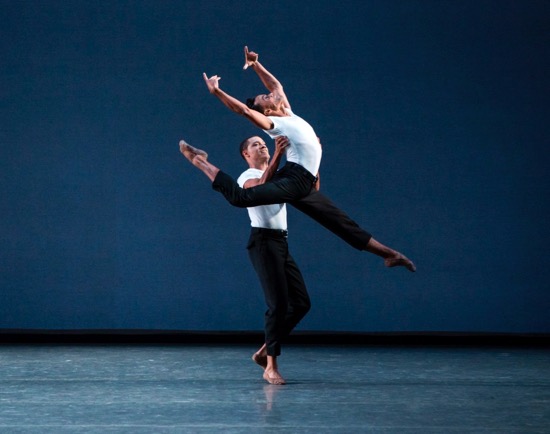
Not Our Fate by Lauren Lovette. New York City Ballet’s Preston Chamblee lifting Taylor Stanley. Photo: Paul Kolnik
Lovette’s choreography often indicates a sense of strain and impetuosity. People form chains and break them. Groups absorb pairs. Certain dancers flash into the foreground, alone or with partners. Two principal dancers join corps de ballet members in two of the work’s four sections. Taylor Stanley is paired with Preston Chamblee in one duet; Ask la Cour with Meaghan Dutton-O’Hara in another. The ballet’s title is hinted at the male duet. Chamblee and Stanley have “chosen” each other, and in their pas de deux, Lovette has opted to use some typical male-female ballet partnering, as well as more unusual linkages. Also interesting, if less noticeable: the group backing these two consists of five women and three men, so two of the women join together.
The duet for la Cour and Dutton-O’Hara is also finely constructed and slightly traditional, although he endangers her by spinning her in a pinwheel, and she collapses rather a lot. They look wonderful together, as do Chamblee and Taylor.
The evening ends with a piece by the most experienced choreographer, the most famous composer, and six of the company’s principal dancers perform it, along with two soloists and one corps de ballet member (I mention these classifications only to point out the splendid dancing that in NYCB often cuts across such distinctions. Choreographer Peck has chosen to create his ballet, Pulcinella Variations, to almost all of Igor Stravinsky’s Pulcinella Suite. It’s the same music heard during the 1972 Stravinsky Festival supporting a ballet by George Balanchine and Jerome Robbins, both of whom, to our delight, appeared in it. The music is a marvel—by turns sweet, playful, sly, raucous, roughhousing, tiptoeing. . . .
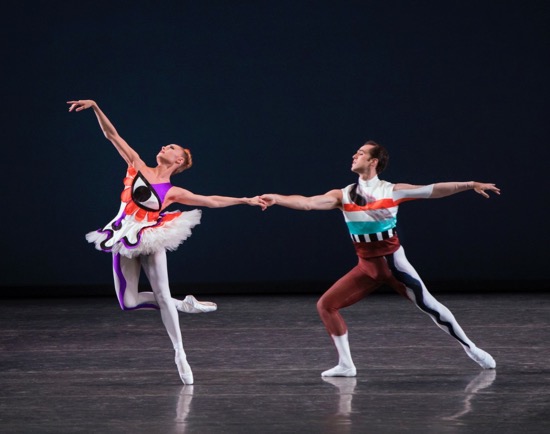
Sara Mearns and Jared Angle in Justin Peck’s Pulcinella Variations.
Photo: Paul Kolnik
In the past five years Peck (who turns 30 this year) has choreographed 18 ballets. He is accomplished in every way: his ideas, his musical choices, his sense of structure, his winning ways of making classical steps “speak” in new ways without being crass. His program note quotes Stravinsky: “Pulcinella was my discovery of the past. It was a backward look, of course—the first of many love affairs in that direction—but it was a look in the mirror, too.” The choreographer is referencing a tradition rooted in the past that he and his colleagues make theirs every day.
In costuming the ballet, designer Tsumori Chisato could have been looking at paintings by Picasso and outfits by Bauhaus designer-choreographer Oskar Schlemmer, circa 1929. It’s as if the costume trunk belonging to a troupe of Commedia dell’Arte performers had burst open, spilling its contents, and, with a show imminent, the performers had grabbed whatever they could and put it on. Indiana Woodward’s half tutu could have been Pierrot’s ruff. Brittany Pollack is checkered like Harlequin, but also wears a little disk of a tutu. The large eye at Gonzalo Garcia’s waist is echoed by the one slanting across Sara Mearns’ chest.
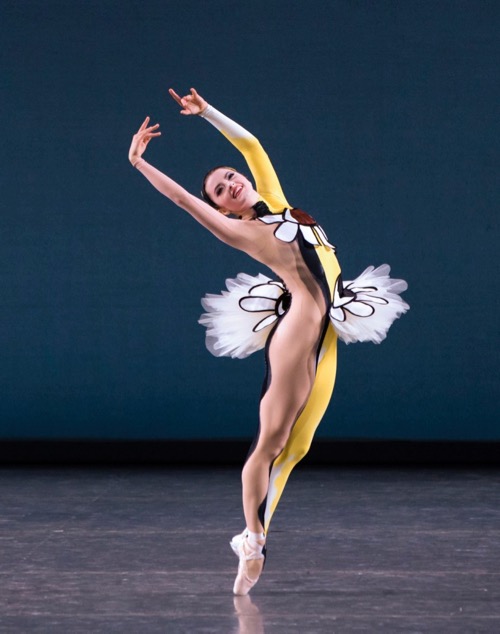
NYCB’s Indiana Woodward in Justin Peck’s Pulcinella Variations. Photo: Paul Kolnik
Pulcinella Variations begins and ends with all nine dancers busy on the gray-draped stage and, in between, weaves them through an array of solos and duets (you can imagine a Commedia director acquainting us with his characters before beginning the play).This little treasure trove of a ballet presents the “lovers,” Mearns and Jared Angle, beautifully attuned to each other, dancing Stravinsky’s “Serenata. ” When Sterling Hyltin is whipping through the “Scherzino,” men peer out at her from the wings. They’d have good reason to eye Woodward in the “Allegretto,” seeing as how one entire half of her body appears to be naked. Pollack shows her poise in the slower “Andantino.” Then the men take their solos—Anthony Huxley nimble and swiftly spinning about the stage in the “Tarantella,” Andrew Scordato calmer in the “Toccata.” The second pas de deux to the “Gavotta (con due variazioni)” is performed by Tiler Peck and Garcia; as always her dancing sings—now flowing, now suspending, now stinging the air.
Everyone appears in the “Minuetto and Finale.” Succeeding one another, mingling, separating, reminding you how vivid their dancing has been, in the end they acknowledge 19th-century ballet’s fondness for posed symmetrical tableaux that practically exhort the spectators to applaud, which we do. And then some.
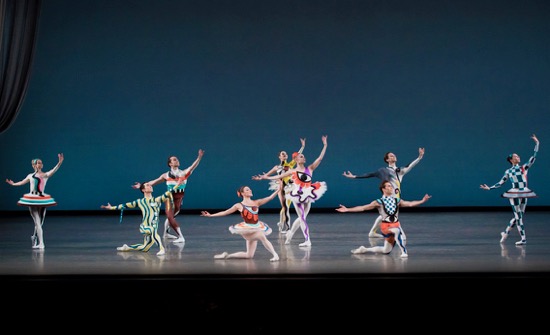
The cast of Pulcinella Variations. (Standing, L to R): Sterling Hyltin, Jared Angle, Indiana Woodward, Sara Mearns, Andrew Scordato, Brittany Pollack; (Kneeling, L to R): Anthony Huxley, Tiler Peck, and Gonzalo Garcia. Photo: Paul Kolnik
The gala evening, which ended with a dinner, earned the New York City Ballet $2.6 million and the donors our gratitude.

A lovely, lucid and detailed discussion. I especially loved your sentence about Peck’s Pulcinella. “The choreographer is referencing a tradition rooted in the past that he and his colleagues make theirs every day.”
There is no choreographer alive whose work I anticipate more than Justin Peck. I salivate over his work the way I used to over a new work by Jerome Robbins or Paul Taylor. I have seen a lot of versions of Stravinsky’s Pulcinella, most of them just perfunctory. Somehow I sense from your fine review that this work is exceptional. I will have to wait until at least spring to see this one. Thanks also for the great pictures. The costuming for Peck’s ballets is always delicious. He has the Midas touch. Also, I can’t imagine what it would be like to choreograph a work for NYCB at age 18.